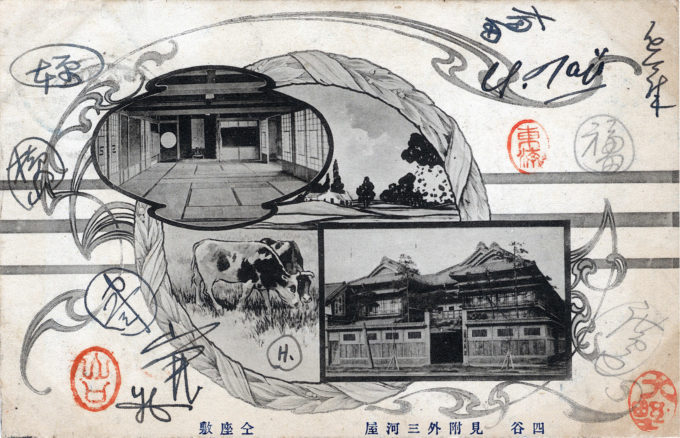“[T]here are nine hot springs in Hakone, viz., Dōgashima, Sokokura, Kiga, Ashinoyu, Kowakidani, Yunohanazawa, Ubako, Gora, and Sengokubara. Here again our road branches off to the left, by which we pass through Kowakidani and Ashinoyu and reach Hakone-machi.
“Kowakidani is only a mile away from here and is now becoming one of the most attractive spots in the mountain with ten thousand cherry trees planted only a few years ago around a pretty hotel, called Mikawaya.
“This place is also called Kojigoku – literally meaning the Small Hell – because of a cave constantly emitting sulphurous fumes. We are told that the boiling water gushed out of the ground hereabout in a great quantity in days past.”
– The Hakone District, by Tomitaro Suzuki, The Tourist, January 1921

Mikawaya ryokan at Kowakidani hot spring, Yotsuya-Hakone, c. 1920. An historic inn established in 1883, and visited by painter Takehisa Yumeji, poet Yosano Tekkan, and Sun Yat-Sen, father of modern China, among other luminaries. The property has now been designated a Tangible Cultural Property of Japan.
Kowakidani, (2, 000 ft.) – 1 m. SW. of Miyanoshita. Kowakidani (‘Valley of the Lesser Boiling’), also called Ko-jigoku (‘Little Hell’), because of the fumes emitted from a cave in the vicinity.
The springs are situated a little less than a mile from the electric car stop. Motor car, ¥1.50, motorbus, 35 sen; rickisha, 35 sen. There is a short cut (5 m.) from the station but no rickishas .
In the spa are one iron and two sulphur springs. The principal spring, Kowakidani-Onsen, is classed as acid vitriol spring – temp. 71° C. – 160° F.
… Besides traces of potassium, chlorine, boric acid, and other organic substances, this water is beneficial for a variety of diseases and afflictions (pg. 34) including ulcers, excessive perspiration, varicose veins, and chronic diseases of the urinary tract and genital organs.
Inn. Mikawa-ya – 55 rooms. This Japanese inn caters European guests (20 rooms). Rates: American plan, ¥ 12. This is the oldest inn in the spa, owns its own springs, and is equipped with 9 private baths.
From Kowakidani there is a very fine view – one of the best in the district – of the Haya-kawa Valley and surrounding mountains . The scenery of the spa itself is yearly becoming more and more attractive. There were planted a few years ago a large number of old cherry trees, of the prized variety named Yoshino-zakura (Mountain cherry), and azaleas in plenty, the variety named Iwatsutsuji, which in May tint the side of Mt. Hõrai a deep red – maples were also set out, to add to autumn’s brilliancy.
– The Hot Springs of Japan, Japan Government Railways, 1922

